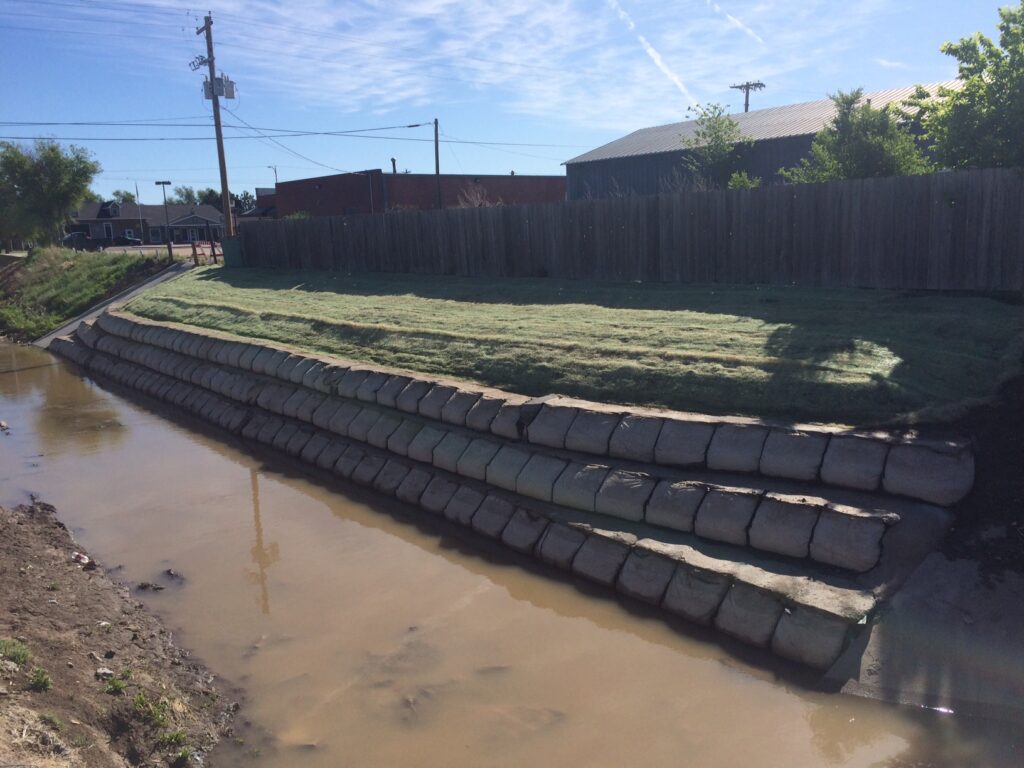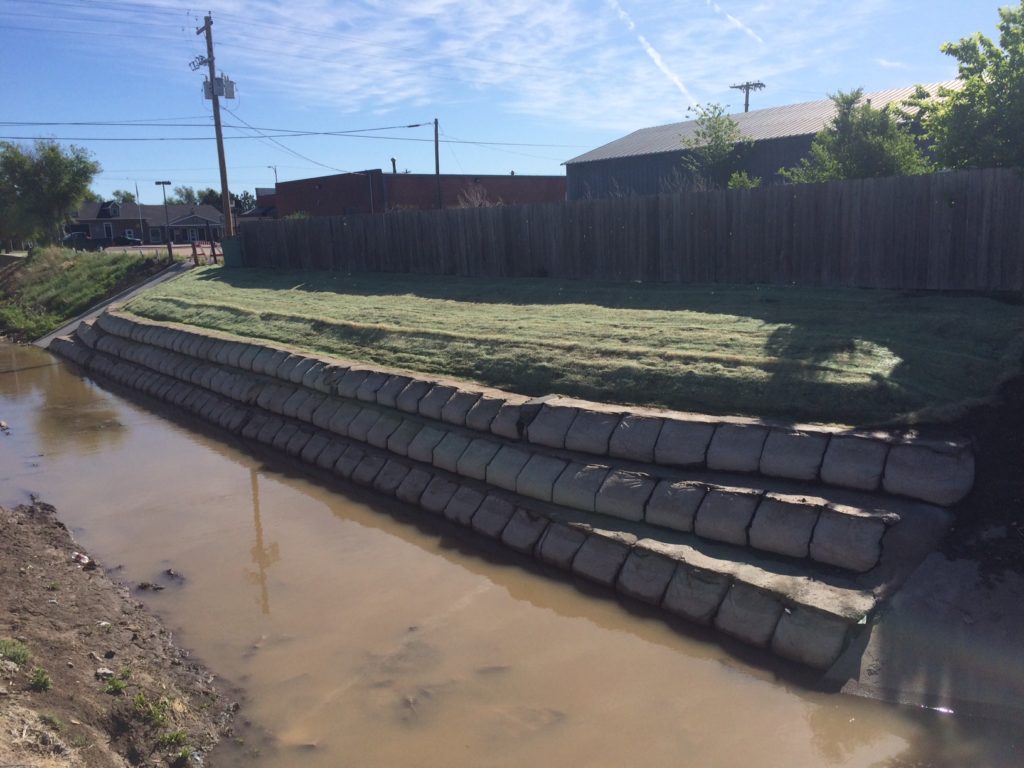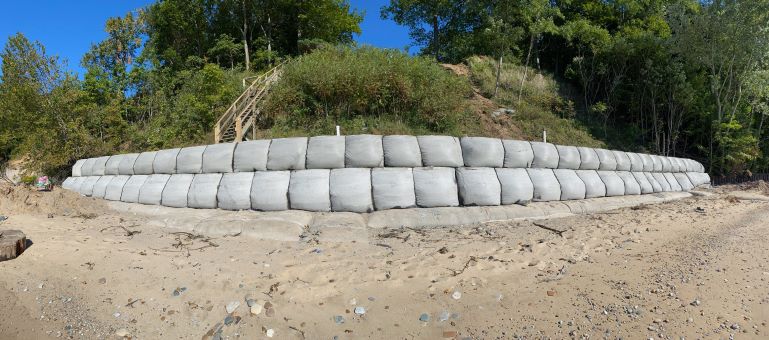Easy Curved Seawall Construction
Learn more about constructing curved seawalls and the benefits of using TrapBag erosion control barriers for your next seawall project.

The waterfront is prone to harsh weather elements and erosion. That puts any property close to the sealine at risk of being damaged by floods or other natural disasters. You can, however, protect your investment by building and maintaining a curved seawall.
Whether you want a traditional seawall reinforced with steel or an innovative option like TrapBags, we’ll cover everything you need to know about curved seawall construction below.
What Is a Curved Seawall?
Curved seawalls are designed to imitate the wave’s shape as it moves towards the land and repels it back to the sea. The concave also prevents the wave from overtopping the wall, providing additional protection.
How Curved Seawalls Work
The curved design dissipates the wave by deflecting it upwards and away from your property as the wave hits the wall. The curve on these walls redirects most of the energy from the incident, resulting in low reflected waves with minimal turbulence. These walls are made by pouring concrete and designed to minimize sediment removal around the structure, weakening it at the base.
Unlike vertical and mound seawalls, which are easy to design but easily undercut by high wave energies, curved seawalls are complicated to engineer and design. However, they are more effective in dissipating wave energy.
Curved Seawall Benefits
Before you decide to start curved sea wall construction, it’s essential to apply the cost-benefit approach to determine whether the sea wall advantages are worth the investment. That said, curved seawalls have the following benefits:
- Prevent erosion – curved seawalls stop natural sediment transportation when a wave hits the shoreline by dissipating the tide back to the sea. Similarly, the wall prevents the movement of sediment from cliff erosion along the shore.
- Prevent flooding – the wall resists the full force of the wave and storm surge. They, therefore, act as a barrier to prevent flooding.
- Effectively decrease wave energy and reduce turbulence – the concave shape of curved seawall deflects the wave upward, decreasing its energy and turbulence impact.
Curved vs. Vertical Seawalls
Vertical seawalls are vertically built to prevent wave energy from eroding the shoreline by reflecting it. They are simple to construct but easily undercut by high waves. Under storm conditions, these walls form standing waves which result in a clapotic surge that moves up and down instead of horizontally. When that happens, severe erosion can occur at the base of the wall, causing severe damage to the wall.
Curved seawall structures, on the other hand, are expensive and complicated to construct. In addition, the concave shape adds a dissipative element to the wall, making it hard for high-energy waves to overtop it.
How to Construct a Curved Seawall
Concrete seawall construction prevents shoreline damage caused by flooding, erosion, and seasonal variations in water levels. These structures are reinforced with steel to protect the shoreline from high wave energy. Below are curved seawall construction methods for a successful project:
Examine the Area
First, examine the area you want to construct your seawall by taking notes of the desired length. Next, make a rough sketch of your shore, including sharp curves and elevations and mark all the points where the poles will go.
Remove Previous or Failed Seawall Materials
Before constructing a curved face seawall, you need to remove most of the preexisting seawall.
Excavate and Install Piling
You need to excavate the water edges where the pilings will stand. Unearthing helps remove any debris that might interfere with the installation of the new structure. The pilings also need to be drilled into the ground beneath as they will help support the wall. Factors such as weather conditions and the type of soil determine the depth of the pilings.
Build the Seawall
Make sure that you have enough material to build your seawall. Curved concrete seawall uses concrete which is enhanced using steel. Install each steel individually to ensure it’s firm, sturdy, and has the same height as others.
Add Tiebacks and Anchor
To enhance the strength of your seawall, you need to add tiebacks at least 6 to 9 feet back from the shoreline. Position every tieback at least 7.5feet along the seawall to enhance support to your wall. Enhance the seawall strength by attaching the tiebacks with anchors inserted vertically to the ground about 4 to 5 feet apart.
Add Backfill
The sea wall construction process uses heavy earthmovers, which disturb the surrounding environment. That’s why it’s essential to add backfill where the old seawall was standing. Sand is the most commonly used backfill material but can sometimes be used with Michigan fieldstone to help protect the shoreline and surrounding structures.
Maintain the Seawall
You can prolong the lifespan of your seawall by providing regular maintenance. During the exercise, remove any plants to prevent their rooting system from creating cracks on your seawall. Also, make sure you unclog the weep holes to help the water move with ease and avoid a dangerous buildup of water pressure that may damage the seawall in the future.
Additional Considerations
Unlike other seawall types, curved sea walls require specific planning. Their design helps dissipate wave energy. You need to carry out experimental research on the kind of waves that frequent the area. This information helps in designing a structure with a practical dissipative element.
Using TrapBags for Seawall Projects
TrapBags are a continuous cellular barrier system used to prevent and protect against natural disasters where artificial solutions are required. They are a perfect solution if you live or have a business close to a river or a large waterbody. TrapBags are effective in protecting against floods, erosion, mudslide, and other types of environmental pollution.
TrapBag seawalls are pentagon-shaped bags that are sloped on one side and filled with concrete. The cells are connected side by side, and although each cell is self-contained, they rely on each for added strength. So even if one cell is compromised, it won’t affect the rest of the barrier.
Due to their effectiveness in preventing environmental pollution and affordability, TrapBags have become very popular among government entities, businesses, and engineers. Using TrapBags in a seawall project has the advantage that they are easy to install and can be installed in flowing water.
FAQs
If you are still unsure about constructing a seawall, we have the answers to your inquiries below.
What Are the Different Types of Seawalls?
There are three main types of seawalls; curved, vertical, and mound seawall.
How Do You Reinforce a Seawall?
After constructing your sea wall, you need to reinforce it using tiebacks and anchors. Screwing the tiebacks into the ground helps pull the wall straight, anchoring it into place.
Are Seawalls Expensive?
How much a seawall cost depends on the type of sea wall you build. For instance, vertical seawalls are straightforward to construct and hence cheaper. On the other hand, curved sea walls have a complicated design and engineering, thus expensive to build.
Start Your Project Today with TrapBag
Although the initial intention of TrapBags was to use them as flood barriers, their versatility has grown over time. Nowadays, they have many applications including, bridge abutments, coastal protection, flooding, cofferdams, and mining.
If you have a project where you require a seawall but are on a tight budget, TrapBags is your best option. In addition to their cost, friendliness and versatility, they also offer longevity. So be sure to try them today, whether looking for short-term flood control or a long-term erosion solution. Browse our products online or contact us today to get started on your next seawall project.
[/vc_column_text][/vc_column][/vc_row]


